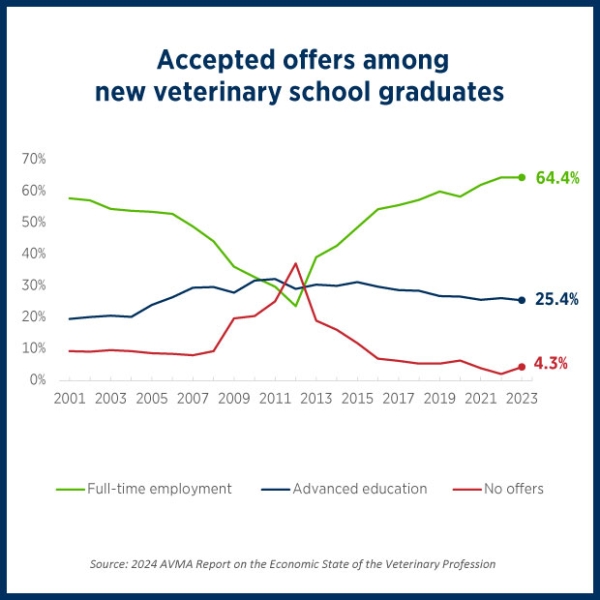Chart of the Month: What’s in your benefits package?
The benefits that come to us as conditions of our employment are key factors that we consider, along with financial compensation, when deciding whether to accept or remain in a job. But how do we weigh them against each other, decide which are most valuable to us, and consider overall benefit packages that contain different offerings?
Knowing what other veterinarians in similar positions are receiving can help us appreciate what’s possible—both as employees and employers—and make informed decisions at the negotiation table.
What the data show
Today’s chart shows which employee benefits are more common than others in the compensation packages of associate veterinarians, as reported in the 2023 AVMA Report on the Economic State of the Veterinary Profession.
As the chart shows, the most common benefits provided to associate veterinarians include licensure reimbursement, paid CE expenses, discounted pet care, paid vacation leave, and payment of association dues. Least common—reported by fewer than 5% of associates—are personal use of a vehicle, informal profit-sharing plan, pet insurance, educational loan repayment, gym membership, pension plan, and housing assistance.
There are some differences between benefits reported in public practice vs. private practice. Notably, public practice veterinarians are more likely to receive benefits that support wellbeing, such as paid vacation leave (82%), paid sick leave (73%), paid legal holidays (69%), employee assistance programs (32%), and paid parental leave (30%).
Do we know what benefits are most valued?
No specific information is available to indicate which specific employee benefits veterinarians consider most valuable. But a 2023 survey by the Society for Human Resource Management does provide some indication across all industries. That survey asked human resource professionals across the nation about the importance of different benefit offerings, and more than two-thirds of respondents identified health-related benefits, retirement savings/planning, leave, and flexible work as very or extremely important to their employees.
What can we do with this information?
Factors like location, work hours, and compensation level certainly are important to associate veterinarians. But employee benefits also can play a pivotal role in recruitment and retention, and may improve employee productivity and engagement. These data provide some guideposts to consider when we are evaluating—or putting together—employee benefits packages.
For veterinarians negotiating or assessing their employment, these figures can serve as benchmarks when appraising an offer, or even when considering alternative career options like public practice.
Equally, for employers, benefits packages are an important differentiator in a competitive job market. These research benchmarks can help build compensation packages that are competitive on all fronts, increasing the attractiveness of a job position. For example, providing an individual and their family with health insurance might sometimes move the needle more than a higher salary.
It’s not one-size-fits-all, of course. Different people prioritize different things, and it can help to be open to negotiation.
More resources
The AVMA salary estimator can help identify salary ranges to provide benchmarks for hiring negotiations for veterinarians in their first six years after graduating from veterinary school. Veterinary jobseekers can find many other helpful resources in the Veterinary Career Center.
These additional AVMA resources can help veterinary employers and hiring managers make informed decisions about compensation and benefits, and identify opportunities to make both recruitment and retention more successful.



Comments
Decoding Employee Benefits: Insights from AVMA's Chart of the Mo
Understanding the landscape of employee benefits for associate veterinarians is crucial in making informed decisions regarding employment. This chart provides valuable insights into the common benefits received by associate veterinarians in 2022, shedding light on the variations between public and private practice.
The breakdown of benefits, from licensure reimbursement to paid vacation leave, offers a comprehensive view of what veterinarians typically receive. The distinction in benefits between public and private practice, particularly the emphasis on well-being in public practice, is noteworthy.
While the data doesn't explicitly reveal which benefits veterinarians value most, the mention of health-related benefits, retirement savings, leave, and flexible work being crucial according to a 2023 Society for Human Resource Management survey adds a broader context. These insights can serve as benchmarks for both veterinarians negotiating job offers and employers structuring competitive compensation packages.
For veterinarians, it provides a basis for evaluating and comparing employment offers, considering factors beyond salary alone. Employers, on the other hand, can use this information to tailor attractive benefit packages in a competitive job market, recognizing that individual preferences vary and negotiation plays a key role.
This data-driven approach aligns with the importance of benefits in recruitment, retention, and overall employee satisfaction. The provided resources, including the AVMA salary estimator and additional tips for veterinary employers, offer practical tools for navigating the complexities of compensation and benefits in the veterinary profession.
Great blog
Very useful information, thanks for sharing
Add New Comment